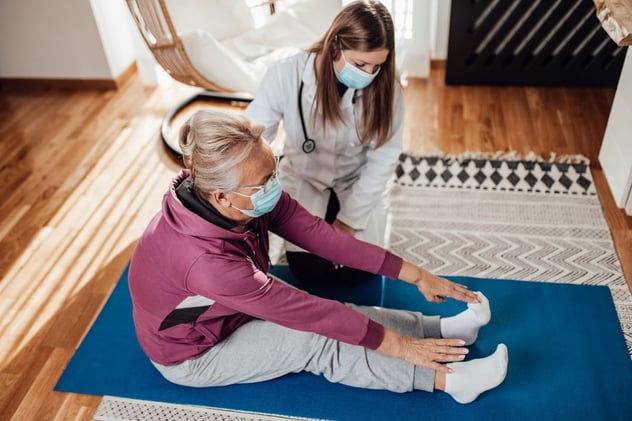
Multiple sclerosis takes many forms and progressions, which have in common a degree of inconvenience in moving around and functioning in one’s environment. Diagnosis is not the end of normal life, but it requires a new attitude toward it, an active attitude to achieving normalcy by all available means. Along with medications, monitoring, and precautions to stay healthy, exercise is essential to managing the progression of MS.
According to the National MS Society, some of the most common symptoms of MS include fatigue, walking (gait) difficulties, spasticity, numbness/tingling, and weakness. Each of these symptoms can be ameliorated by exercise—specifically, professionally administered mobility training. It’s easy to confuse flexibility and mobility. According to the Mayo Clinic, “flexibility refers to the ability to move a joint through the full range of motion, or fully lengthen a muscle. Mobility involves a bit more. It includes flexibility, as well as strength, coordination and balance.” Mobility training is about making movements efficient and functional.
Our physical and occupational therapists recommend specific exercise protocols to maintain mobility. We understand that individuals with MS need expert monitoring and guidance that changes as their condition changes. Exercise programs that incorporate mobility training can have far-reaching positive effects beyond movements of daily living. Here are some of the mobility tools we use to holistically address the ebbs and flows of MS symptoms.
1. Progressive Strength Training
Joints do not move themselves. Every movement is an expression of muscle strength and control. Building strength through a full range of joint movement can help restore lost abilities and guard against the effects of the next MS attack. We are proactive in building strength throughout the body, as all movements involve a supporting cast of muscles.
Lower body and postural muscles are areas most commonly affected by MS. That means lots of hip hinges, knee bends, spinal control and ankle flexing are prescribed. Many patients will benefit from simple body weight movements such as chair squats.
When the patient is able, we train movement patterns, but even if a muscle is not able to perform in a normal movement pattern, it can be trained for time under tension by performing isometric holds such as leg extensions, wall sits, planks, glute bridges or other timed contractions without much movement. Isometrics can also be done against a static object like a partner or a wall. We can adapt strength training methods for those minimally impacted by MS as well as those who are dependent on ambulatory aids—we commonly use strength work for mobility training for seniors.
2. PNF and dynamic stretching for mobility
Spasticity is a condition of muscle tightness or spasming common when neurons are damaged from MS. According to Diana Duda, Coordinator of Clinical Education at Penn Medicine, stretching is “the best way to maintain your range of motion and ease symptoms related to spasticity.” Many physical therapists use a stretching technique that may not be familiar to reintroduce your body to end-range positions called PNF stretching. PNF Stands for Proprioceptive Neuromuscular Facilitation. By alternating stretches with muscle contractions, PNF stretching can allow your muscle to lengthen farther and to apply force in those new positions. Here is an example of a PNF contract-relax hamstring stretch commonly used. This effective form of stretching requires professional guidance.
Yoga, Pilates, and tai chi can be fun methods of mobility training that also utilize dynamic stretching, which may have added mental benefits and obvious social motivations beyond the PT table.
3. Gait Training
One of the most common mobility issues for those with MS is the difficulty of smooth, efficient walking. Walking takes muscle strength, coordination, and quick adjustments to the perceived environment. The first thing we do is a gait analysis to determine what factors are influencing dysfunctions. The rehab toolbox for gait training includes general resistance training and highly specific foot exercises. Here is one for foot drop, a common lack of responsiveness in the forefoot that can lead to exaggerated high steps, foot dragging and uncontrolled slapping of the foot to the ground.
Repetition builds strong neural pathways, as in the simple repeated walk, sit, walk exercise here. Treadmill exercise with bodyweight support can be useful to gain repetitions while walking properly without the distraction of maintaining balance; this is especially useful for mobility training for seniors. Other times, when sensation, or “proprioception,” is the major issue, we may take a lighter touch, using brush therapy or mirror techniques to build a finer awareness of the body in its environment.
4. Aquatics
Pareses, a condition of partial paralysis and muscular weakness caused by nerve damage, is common with MS, but our physical therapists and occupational therapists can keep you moving forward even during these setbacks. Hydrotherapy is any mobility training (especially used as mobility training for seniors) performed in warm water—warm because it helps muscles to relax and lengthen. There are many methods of hydrotherapy as seen here. The buoyancy of one’s body in water makes movement possible that may not be otherwise, while the warm water encourages blood flow and relaxation.
Exercise can make a huge difference in how you function with MS and feel about yourself. According to a 2008 journal article from Sports Medicine, “Exercise exposure (preconditioning) may serve as a mechanism to enhance stress resistance and thereby may support neuronal survival under heightened stress conditions. Considering that axonal loss and cerebral atrophy occur early in the disease, exercise prescription in the acute stage could promote neuroprotection, neuro-regeneration and neuroplasticity and reduce long-term disability.” In other words, exercise now, fare better later. It’s not as simple as “just do it” for those with MS, however. Aerobic, strength and balance training all have their place but they must be matched to ever-changing symptoms and abilities.
MS has ups and downs, but mobility training applied consistently can make recovery faster and muscle function more resilient. According to the article “Exercise in Multiple Sclerosis - an Integral Component of Disease Management, “MS patients have been shown to have more brain areas, often bilaterally, activated when performing motor and cognitive tasks compared to healthy controls, possibly as an expression of neuroplasticity. In short, the brain is looking for new ways to do things, seeking to build new pathways. With repetition and sound programming, Rehab Select therapists can help MS patients build and maintain those pathways through consistent and professionally guided mobility training. Are you interested in touring our facility to explore these various training applications? Schedule a Tour.




